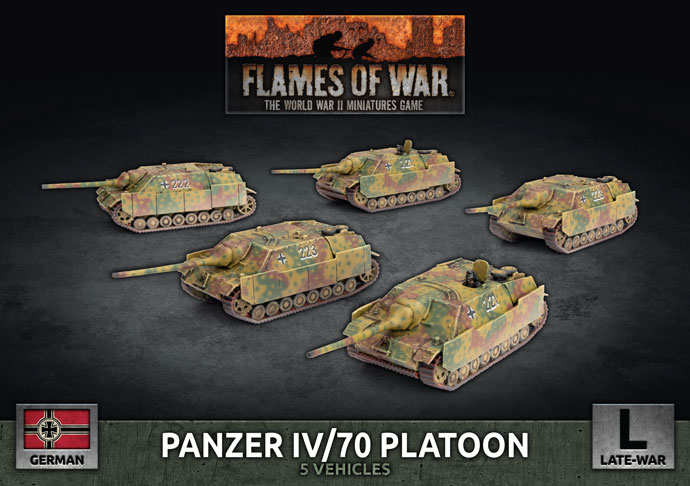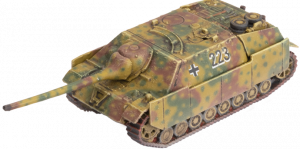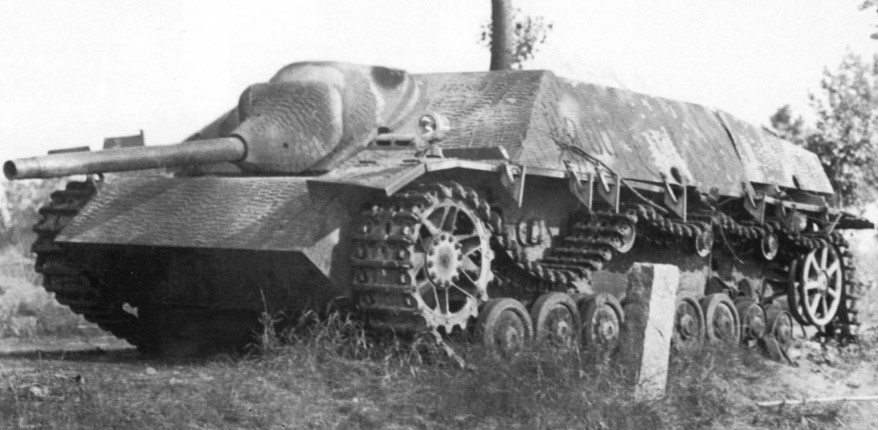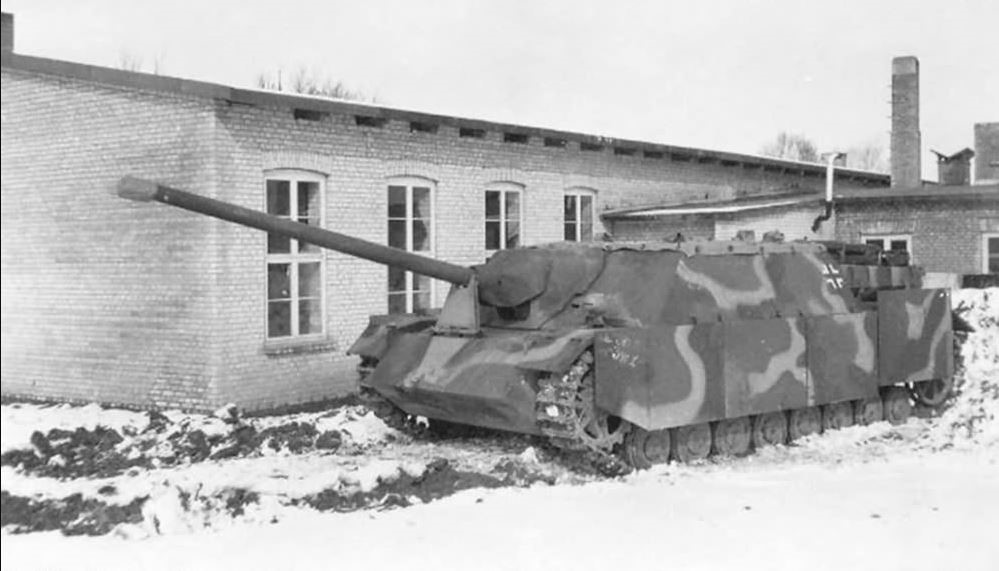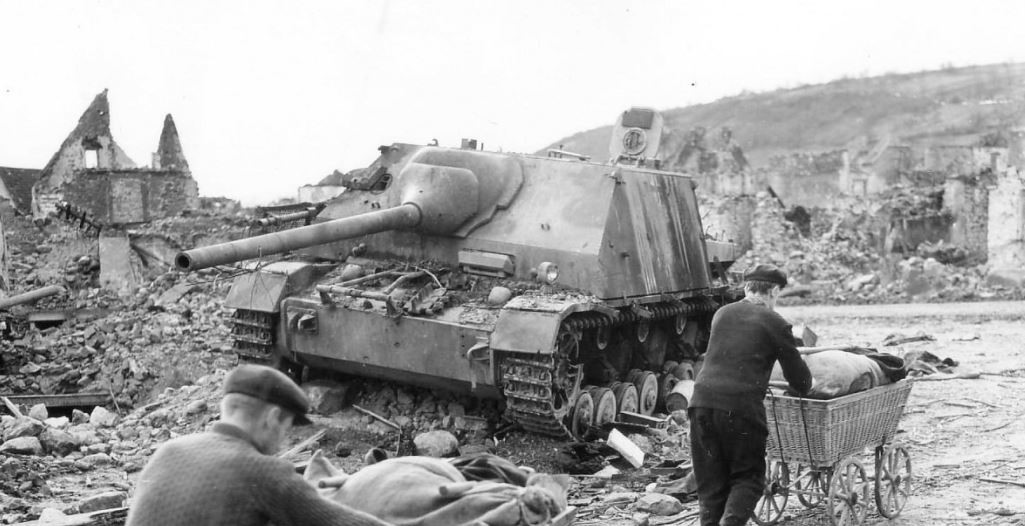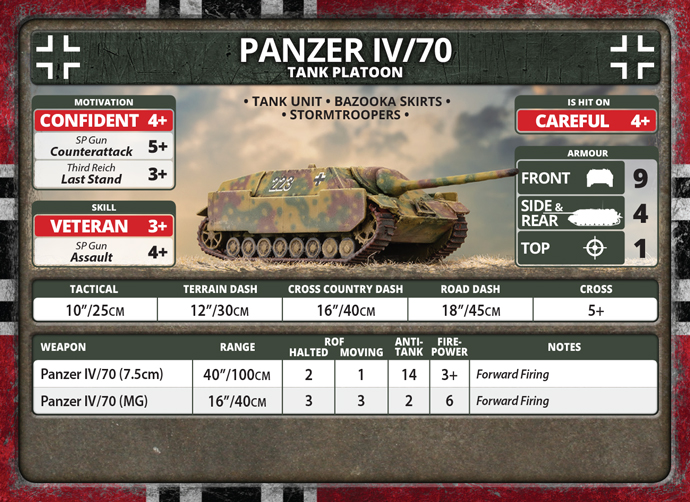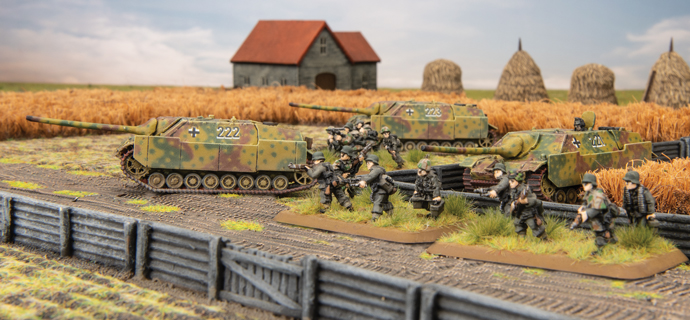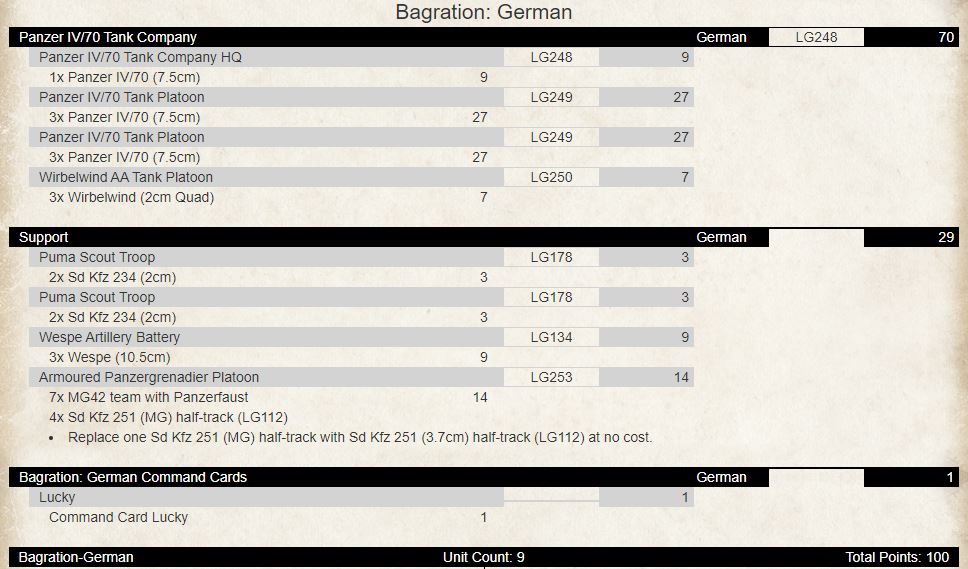With Adam Brooker
The idea for the Panzer IV L/70, or Jagdpanzer IV/70, was for it to be the successor to the very successful Sturmgeschütz III (StuG III). The StuG III was an infantry assault gun that was initially designed and implemented to support infantry in assaulting dug in positions, but when pushed into the role of a tank destroyer proved very effective, due to its low profile and when upgraded with a 7.5cm StuK 40 L/43 and L/48 cannon, it could penetrate the T-34 and Sherman frontally at ranges in excess of 1000 meters.
In 1942 the initial specifications for the tank destroyer based on the Panzer IV chassis (to reduce the number of different vehicles being produced) as a casement-style turretless tank destroyer, with 100mm of armour frontally, with 40 to 50mm on the sides, and to mount the excellent 7.5cm L/70 gun that the Panther was using so successfully. It was also to have as low a profile as possible, similar to the StuG III previously, which was excellent for ambushes. VoMAG was successful in using an almost unaltered Panzer IV chassis in their design and it was accepted, with a mild steel version submitted for the Fuhrers approval in late 1943.
During the design phase it was found that 100mm frontal armour specified was not practical, so an angled 60mm of armour was used instead, and after about 300 vehicles were produced in May 1944, this was increased to 80mm of armour which gave approximately the same level of protection. The frontal armour was also made of interlocking plates welded together to also make production easier and faster.
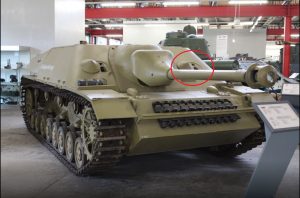
It was also noted that initially little or no consideration was given to how the extra weight of the much longer gun would affect the driving characteristics of the Panzer IV chassis, as Hitler had ordered it to go into production immediately and it seemed bad things happened to people who did not follow the Fuehrer’s demands immediately! (unreasonable or not…)
It had the effect of making the tank destroyer very nose heavy, especially when combined with the additional front armour that was also specified in the design. To further reduce this weight at the front, the spare track links which were originally stored at the front like the Panzer IV were moved to the rear. But overall this weight made them less mobile and very difficult to operate in rough terrain, and crews gave it the nickname “Guderian’s Duck”, poking fun at the General that was given a vehicle he did not want or felt was needed.
Heinz Guderian was the Inspector General of Armoured Troops at the time, and an early advocate of the Blitzkrieg style of warfare the Germans employed successfully in Poland, France, and Russia, and was very against yet another conversion of a successful design. He felt it diverted resources away from the production of the Panzer IV, and it was not needed, as the StuG III was doing a perfectly reasonable job at the time. Arguably at the time, 1942-1943 it was, but as the war progressed it started to struggle, as heavier Allied designs took the field.
Looking back at German tank production during WW2, it has been noted by many scholars that the Germans wasted a lot of resources and time on different variants and designs, based on successful chassis that could have been better spent on producing more of the proven designs, like the Panzer IV, Panther and StuG III.
The Allies had shown by producing tanks like the Sherman and T-34, with very little variation except for new turrets and up-gunning, that this often was not needed or warranted. But the Allies could afford to replace losses in tanks and manpower easily, where the Germans could not, and often had to do a lot with a little.
Additionally, with the increase on heavier Soviet designs on the Eastern Front like the T-34/85 and KV and IS tanks, and British Churchill tanks on Western Front, German designs like the Panzer IV and StuG III were lacking the penetrating power at the range and found that they needed to engage the enemy at closer and closer ranges to be successful.
The Germans needed, especially on the Eastern Front (where they were taking most of their losses and facing the bigger foe), to knock out Soviet tanks at the range, before the enemy tanks got into effective range themselves, to keep an effective kill ratio. So the L/70 gun on the Panther, on the large open battlefield of the Eastern Front, was perfect for this. So there is definitely a need for this type of tank destroyer on the Eastern Front, but probably not so much on the Western Front, where most tank engagements were short range firefights, more akin to a knife fight than the long range tank duels and mass charges of the Eastern Front.
So it is arguable that the Germans did need many of these variants they produced (except probably not vehicles like the King Tiger, Jagdtiger), given the different landscapes they were fighting in, but did not have the resources or manpower needed to be successful on the multiple fronts they were fighting on. The further the war dragged on, the more time the Allies had to wear down Germany, and with the Allied superiority in resources and manpower, draining the lifeblood of Hitler’s war machine, it was only a matter of time. But the Germans were aware of this, even at the start, which is why they needed to win in Europe quickly with their Blitzkrieg style warfare to not get bogged down in a prolonged multi-front war, which they knew they would probably lose….. Anyway, I digress….. Back to the Panzer IV/70.
The design was accepted and went into production immediately, but initially only fitted with the 7.5cm L/48 gun, as there was a shortage of 7.5cm L/70 guns, due to the priority on Panther production. Initially, about 800 were produced from Jan 1944 to November 1944 with the shorter L/48 guns with a muzzle brake, and are commonly referred to as Jagdpanzer IV, or just Jagdpanzer.
As you can see in many historical images, the muzzle brake was removed by crews in the field, as they found the dust clouds it kicked up after firing (due to the vehicle being so low to the ground), betrayed their position immediately, which would necessitate them re-positioning after only one shot. Later variants would all be produced without a muzzle brake. Later when the intended 7.5cm L/70 became available, two different variants of the Panzer IV/70 were produced, the Panzer IV/70 (V) and the Panzer IV/70 (A).
The Panzer IV/70 (V), with the V standing for VoMAG the manufacturer, with the longer barrelled 75mm Panther L/70 gun (that could outrange any allied weapon), was produced between August 1944 to April 1945, with about 940 manufactured. This was the most produced version, and VoMAG stopped producing any Panzer IV tanks at all, to concentrate entirely on the production of the Panzer IV/70. But it seemed initially
The other version produced with the 75mm L/70 gun was the Panzer IV/70 (A), this was made by Alkett, and was done to speed up the production of 75mm L/70 gun equipped vehicles to the front line, and not an interim design as some have speculated previously. Alkett normally made StuG III and Panzer IV tanks from its Nibelungenwerke Factory, it was ordered to quickly design and produce a 75mm L/70 armed tank destroyer on a standard Panzer IV chassis and not a modified chassis like the VoMAG design was, which allowed its very low silhouette. To do this required additional vertical steel plates be added to mount the L/70 gun on the standard chassis, this increased the height to 40cm, and it lacked the sharp nose of the VoMAG variant. Around 278 were built at Nibelungenwerkefrom from August 1944 to March 1945.
Originally the plan was for all Panzer IV tank production to stop and to focus on Panzer IV/70 production, but this never happened. The dire need for vehicles on both fronts, and delays in vehicle production that this would necessitate and that the turreted Panzer IV was still a very good tank and had advantages that a hull mounted tank destroyer did not all played into this decision. If this had happened, I think it would have only made the situation worse for the Germans.
In combat, when given to experienced crews, they performed well. In November 1944 Panzer-Regiment 2. was given 11 Panzer IV/70 (A) to replace losses to their Panzer Companies, and during fighting in the Colmar Pocket they reported the loss of 3 tank destroyers, but at the cost of 50 enemy tanks.
They fought on both the Eastern and Western Fronts, as replacements to Panzer Divisions and Tank Hunter Battalions, often as part of mixed companies, fighting alongside, StuG’s, Panzer IV’s, and Panthers. They were noted especially in the Fuhrer Begleit Brigades fighting in the Ardennes and in the defence of Budapest in Hungary. They were also in the Schwere Panzerjager Abteilung 655 which included Jagdpanthers, StuG III, Hornisse, and Panzer IV/70s, but they were often broken up into different companies and spread out to try to make the most of their firepower. They were also given to SS Panzerjager Battalions and fought on both Fronts depending on where the parent SS Division was located at the time. It appears that most of the vehicles produced in 1944 went to the western front, but from Jan 1945 onwards with the Soviets smashing the German defences in the Bagration Offensive, the East became the priority. As a side note, the practice of putting zimmerit on vehicles was stopped by September 1944, so any vehicles produced after that were produced without the time-consuming process of the nonmagnetic covering.
Overall their combat effectiveness was mixed. When used in their proscribed role, of a tank destroyer, they performed well. Their low profile, good armour protection, and excellent gun allowed them to effectively ambush enemy tanks at ranges that their targets could not reply from. But when forced into the role of a tank or infantry assault gun, they did not, mostly due to their poor handling in difficult terrain ( due to their nose heavy design) and lack of a turret. This was happening more and more in the war’s later stages, as they were used to replace mounting losses.
One notable Panzer IV/70 ace was Rudolf Roy, who was attached to 12th SS Division Panzerjager Abteilung and died fighting in the Ardennes offensive. In the Normandy fighting his Panzerjager 39 was defending Hill 111 near Soignolles, Normandy, against the Polish 1st Armoured Division. You can find his Command Card in the German D-Day Waffen SS Command card pack, in that card he is fielded in a Jagdpanzer 7.5cm L/48, not a Panzer IV/70, but still is good to see he is represented.
He personally knocked out 9 Polish Shermans and stalled the Allied advance to allow the Germans to retreat successfully that evening. The Polish attacked again that night, with a surprise thrust in the middle of their Kampfgruppe, and he again led his Panzerjager, and on his own initiative, flanked the attacking 15 Polish Shermans, knocking out another 4 personally, with only 2 Shermans from the 15 escaping intact. In the fighting withdrawal over the next 5 days, he knocked out a total of 26 tanks, and earning himself an Iron Cross, with his total at the time of his death approximately 36 British and Soviet Tanks. He was eventually killed in the Ardennes Offensive when his unit was attacking the US 99th Infantry Division, and he was shot by a sniper while looking out his panzer’s hatch during an assault.
Enough about history, how do these Panzers play in game? Well, their FA of 9 is excellent, just as good as a Tiger or Panther, with essentially the same gun as the Tiger and Panther too!! So frontally it can take a hit and dish one out, and it’s 2 points cheaper than a Panther and 3 points cheaper than a Tiger… so what’s not to love??
Well, its downside is its lack of turret and its low side armour of 4, which means it really does not want to be flanked, as unless it does a blitz on 3+, it will have to move to fire, which lowers its RoF to 1, and that assumes it survived the flanking shot… Also, it does not want to be assaulted as it’s a self propelled gun, so has the usual penalties in Assault and Counter-attacking. On the plus side, it does have an MG to protect against infantry, but it is forward firing as well, so make sure you are facing any infantry close enough to assault you, or you are a dead duck!! Also, beware of any cross tests you need to make, a 5+ means you will most likely fail…
But if you use them in their intended role, as long-range and even better ambushing tank destroyers, you can’t go wrong. Their 4+ to hit, especially if you are at long range and concealed, combined with your FA 9, will mean you are very hard to kill. But I would suggest not ambushing from a forest unless they either won’t need to move much or have something to protect or dissuade infantry assault, as they will not be moving out of that difficult ground quickly.
I think these will work best as either a support unit of 3 or 4, as dedicated tank destroyers and ambushers in an infantry force, or as part of the German Bagration Tank Company with Panzer IVs, where they can act as the big guns in your list and the Panzer IV as your jack of all trades.
But they can also work as their own Panzer IV/70 Company, I have made up a list below, that while not an easy list to play, can do well in the right hands. Make sure to use the Pumas to expand your deployment zone if possible, but don’t be too cavalier with them either, their role is to annoy, not to hunt tanks. But I do enjoy gunning down self propelled infantry with them… I also like the weight of fire the Wirbelwinds can add, and the new kits for them look awesome. The armoured Panzergrenadiers also allow you to counter-attack your opponent’s objective quickly as well, and the hail of MGs they can spit out is impressive as well!
Well, I hope you have found this as interesting as I did, and you grab a box of these “Flat Panzers” to add to your forces. I used to enjoy running a company of these in older versions, and the cut-price Panthers did well for themselves then too, and I’m sure they will now as well.

